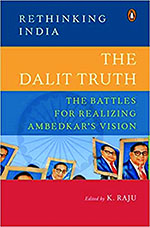After more than seventy years of Independence, the caste question remains one of the most intractable vices of contemporary India. Dalits’ struggles in particular have been made strategically invisible amidst the call for how the ‘dreams of our nation’ must always supersede ‘sectarian agendas’. Both are politically loaded terms. In this sanitized binary, the conceptualization of a ‘nation’ seeks to iron out the quotidian social fissures of the society whereas the term ‘sectarian’ invariably implies the only way of life a Dalit seeks to live. The monstrosity of casteism gets whittled down to shady ‘identity politics’. Whoever speaks of the ‘nation’ becomes capacious and forward looking in their outlook. The one who speaks the language of caste gets blacklisted as an apologist of a blinkered and regressive way of life.
To address and rectify this popular perception, a normative and practical reinstatement of the letter and spirit of the Constitution is essential. The book under review, The Dalit Truth: The Battles for Realizing Ambedkar’s Vision attempts to map the challenges faced by Dalits and offer practical solutions. This is the eighth volume in the Penguin Rethinking India series whose main focus is to start a ‘national dialogue’ on all the burning issues and challenges of our times. The book is edited by K Raju, former IAS officer and current national coordinator for SC, ST, OBC and minorities departments of the All India Congress Committee. Even with the obvious political affiliations of the editor, the volume includes not just a mapping of Dalit hardships and sufferings but also offers a basic critical inquiry into the possible reasons for Congress’s demise as an important stakeholder in Dalit politics. In the introduction, the readers are made aware of the two main approaches of the book—constitutional promises made to Dalits and their results and how far Dalits have progressed on the path shown by Ambedkar. This is not an academic book. The primary purpose of the book is to make Dalit realities visible to the masses in a lucid and accessible language. Although this approach is necessary for a non-combative engagement of issues pertaining to caste, the innate complexities of the Dalit reality are bound to remain underexplored, receiving at best perfunctory observations for deep intersectional sufferings.
Chapters are thematically divided into polity, economy, and culture. Most of the chapters document the challenges whereas a few others provide concrete, policy-oriented solutions. A mixture of young, intrepid scholars along with seasoned researchers construe the ‘Dalit subject’ as an aspirational citizen, where the focus primarily remains on the rapidly urbanizing India. Topics range from the more traditional issues of conflict like reservation and education to how Dalits have featured in and responded to Hindutva, caste and class binary, entrepreneurship, judicial overreach, and the call for internationalizing the caste question among others. As much as highlighting these topics is vital to underscore the historical denial of Dalit plight, the approaches taken to explore these multitudes of Dalit truths sometimes become the reasons for its own downfall. While chapters that deal with specific problems manage to retain the intricacies and deftness of its limited yet polished arguments, other chapters, while making sweeping observations, are neither self-explanatory nor convincing in their emphatic claims.

